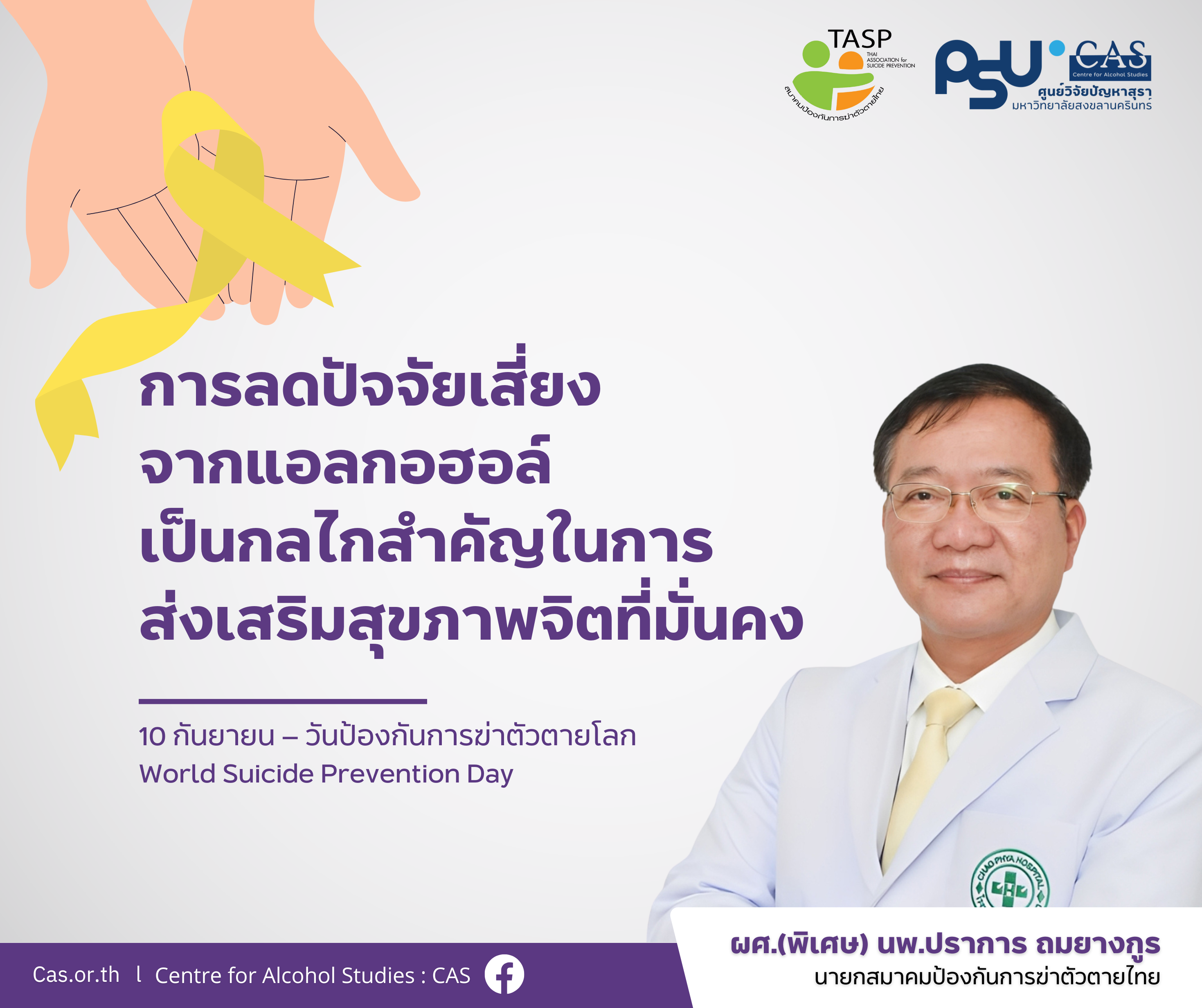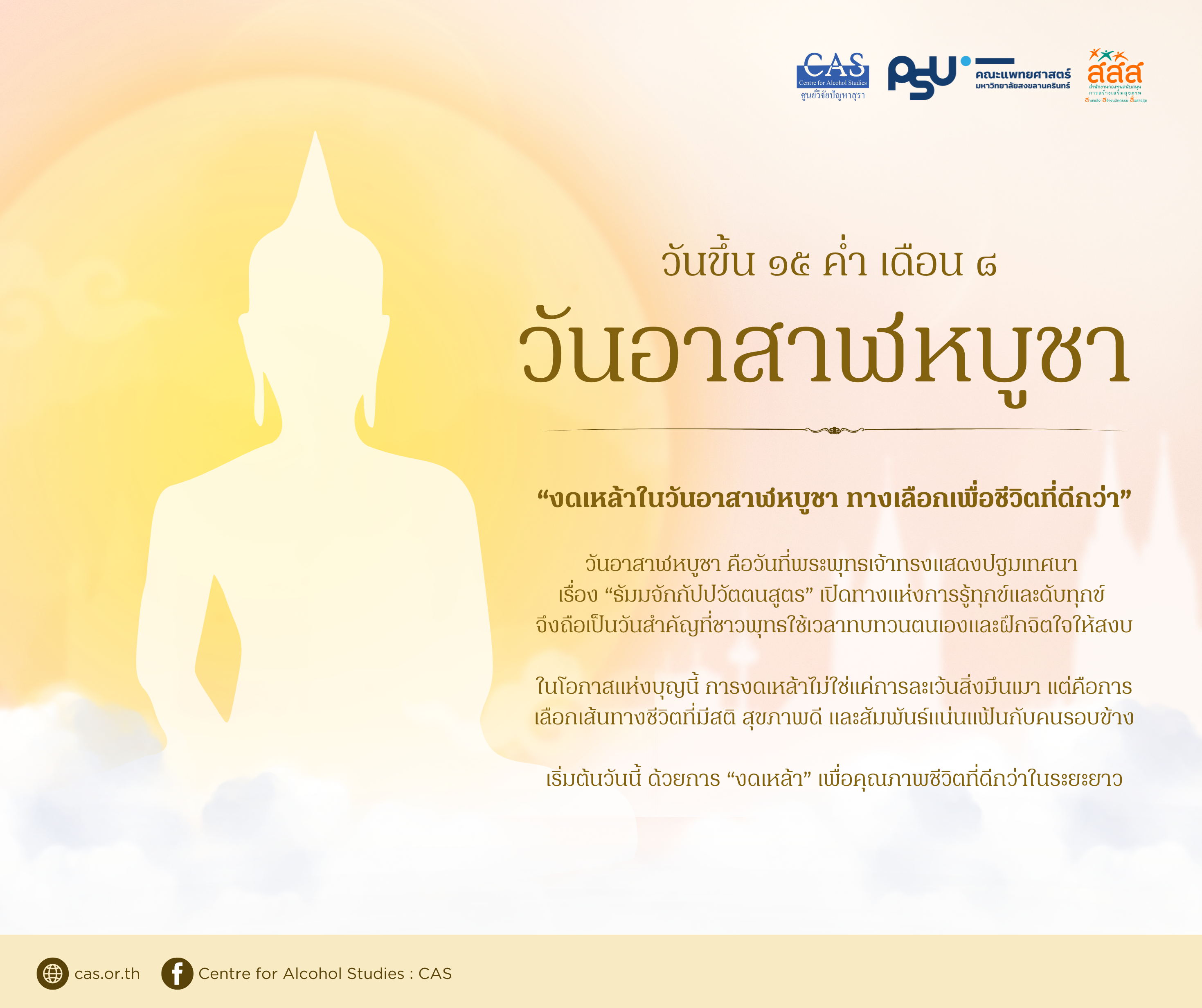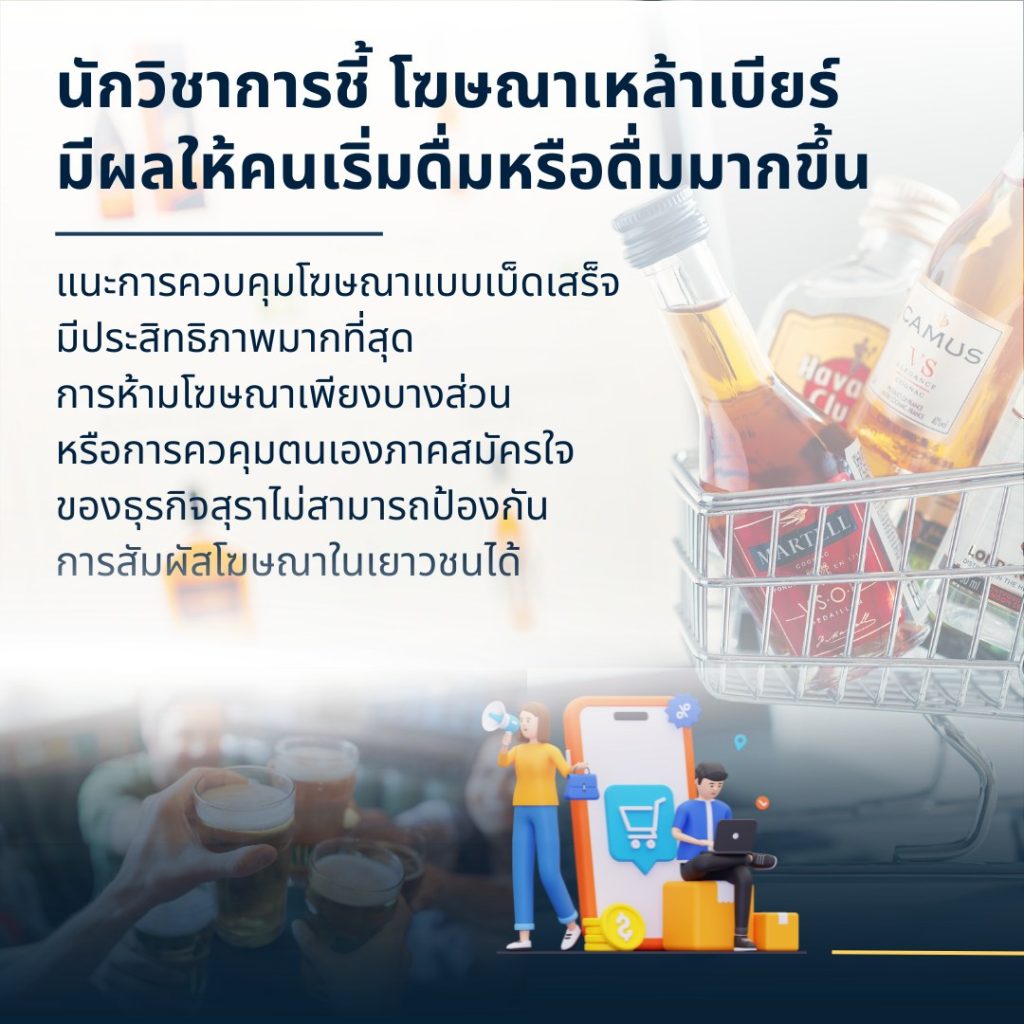การจำกัดสิทธิเสรีภาพส่วนบุคคลเพื่อควบคุมผลกระทบจากการบริโภคเครื่องดื่มแอลกอฮอล์เพื่อความสงบสุข ความปลอดภัย และสุขภาวะของประชาชนโดยรวมจำเป็นแค่ไหน
โดย นางสาวจินตนา จันทร์โคตรแก้ว สำนักงานพัฒนานโยบายสุขภาพระหว่างประเทศ
กฎหมายได้ถูกออกแบบมาเพื่อให้เกิดความสงบสุขของคนในสังคมโดยรวม การควบคุมการบริโภคเครื่องดื่มแอลกอฮอล์ก็เช่นกัน ปัจจุบันสังคมให้ความสำคัญกับการเคารพสิทธิเสรีภาพส่วนบุคคล จนบางครั้งอาจไม่ได้คำนึงถึงความสงบสุขโดยรวมของสังคม เช่นเดียวกันกับการควบคุมเครื่องดื่มแอลกอฮอล์ที่เป็นประเด็นในสังคมที่หยิบยกออกมาโต้แย้งว่า ประเทศไทยมีการจำกัดสิทธิเสรีภาพส่วนบุคคลโดยใช้นโยบายควบคุมเครื่องดื่มแอลกอฮอล์มากจนเกินไปจนไปลิดรอนสิทธิเสรีภาพส่วนบุคคล ทั้งการจำกัดสถานที่ห้ามดื่มและห้ามขาย จำกัดเวลาการขาย การห้ามโฆษณาเครื่องดื่มแอลกอฮอล์ บทความนี้จะฉายภาพให้เห็นอีกด้านของผลกระทบและความจำเป็นในการจำกัดสิทธิส่วนบุคคลเพื่อประโยชน์ส่วนรวมในสังคม
ขอบเขตและสิทธิเสรีภาพของบุคคลในรัฐธรรมนูญราชอาณาจักรไทยฉบับพุทธศักราช ๒๕๖๐ มาตรา ๒๕ ระบุไว้ว่า สิทธิและเสรีภาพของปวงชนชาวไทย นอกจากที่บัญญัติคุ้มครองไว้เป็นการเฉพาะ ในรัฐธรรมนูญแล้ว การใดที่มิได้ห้ามหรือจํากัดไว้ในรัฐธรรมนูญหรือในกฎหมายอื่น บุคคลย่อมมีสิทธิและเสรีภาพที่จะทําการนั้นได้และได้รับความคุ้มครองตามรัฐธรรมนูญ ตราบเท่าที่การใช้สิทธิหรือเสรีภาพเช่นว่านั้นไม่กระทบกระเทือนหรือเป็นอันตรายต่อความมั่นคงของรัฐ ความสงบเรียบร้อยหรือศีลธรรมอันดีของประชาชน และไม่ละเมิดสิทธิหรือเสรีภาพของบุคคลอื่น นั่นแสดงให้เห็นว่าการมีสิทธิเสรีภาพมีขอบเขต บุคคลมีสิทธิในการกระทำใดใด หากการกระทำดังกล่าวไม่ไปกระทบเสรีภาพของบุคคลอื่น ดังนั้นจึงขอไล่เรียงข้อโต้แย้งในคำกล่าวที่ว่า การควบคุมการบริโภคเครื่องดื่มแอลกอฮอล์ลิดรอนสิทธิเสรีภาพส่วนบุคคลเกินความจำเป็นดังนี้
- การจำกัดสถานที่ห้ามขายและห้ามดื่มเป็นการจำกัดสิทธิเสรีภาพส่วนบุคคลหรือไม่ สังคมจะเป็นเช่นไร หากสามารถขายและดื่มเครื่องดื่มแอลกอฮอล์ได้ทุกที่ หากสังคมเป็นเช่นนั้น การกระทำของบุคคลเพียงคนหรือสองคนอาจจะทำให้คนส่วนใหญ่ได้รับผลกระทบ เช่น การดื่มเครื่องดื่มแอลกอฮอล์บนชายหาด ซึ่งชายหาดเป็นสถานที่พักผ่อนหย่อนใจที่คนทั่วไปใช้ชีวิตเพื่อพักผ่อนและใช้เวลาร่วมกัน แต่หากมีกลุ่มคนที่ดื่มเครื่องดื่มแอลกอฮอล์แล้วส่งเสียงดังทะเลาะวิวาท การเรียกร้องสิทธิแบบนี้มีความยุติธรรมกับคนที่ใช้พื้นที่ดังกล่าวจริงหรือ เช่นเดียวกัน การดื่มเครื่องดื่มแอลกอฮอล์บนรถโดยสารสาธารณะ ซึ่งรถโดยสารสาธารณะเป็นสถานที่สำหรับผู้เดินทางและคนในสังคมต้องการความปลอดภัยในชีวิต หากมีเพียงคนเดียวดื่มและส่งเสียงดัง อาจจะทำให้ผู้ร่วมโดยสารคนอื่นๆ รู้สึกไม่ปลอดภัย จากหลักฐานเชิงประจักษ์ การควบคุมสถานที่ห้ามขายและห้ามดื่มเป็นมาตรการที่มีประสิทธิภาพในการควบคุมการบริโภคเครื่องดื่มแอลกอฮอล์ (1) นอกจากนี้การจำกัดใบอนุญาตในการห้ามขายก็มีความจำเป็นเนื่องจากจำนวนใบอนุญาตที่มากขึ้นนำไปสู่การดื่ม (2) และปัญหาที่ตามมา (3) ประเทศนิวซีแลนด์เป็นตัวอย่างในการจำกัดใบอนุญาตการขายเครื่องดื่มแอลกอฮอล์โดยเฉพาะร้านที่มีที่นั่งดื่ม โดยการที่จะมีร้านที่ขายเครื่องดื่มแอลกอฮอล์ได้นั้นจะต้องได้รับการพิจารณาจากคณะกรรมการหลากหลายภาคส่วน ในกระบวนการออกใบอนุญาตขายเครื่องดื่มแอลกอฮอล์นั้น จะต้องมีการติดประกาศเพื่อให้ทราบล่วงหน้าว่า กำลังจะมีร้านจำหน่ายเครื่องดื่มแอลกอฮอล์เปิดขึ้น และประชาชนที่อาศัยอยู่ในบริเวณใกล้เคียงสามารถคัดค้านการเปิดได้หากมีแนวโน้มจะได้รับผลกระทบจากร้านที่จำหน่ายเครื่องดื่มแอลกอฮอล์ดังกล่าว (4) นอกจากนี้ ในสหราชอาณาจักร และออสเตรเลีย ได้มีความพยายามในการจำกัดจำนวนของร้านจำหน่ายเครื่องดื่มแอลกอฮอล์ โดยเฉพาะร้านแบบนั่งดื่ม (5, 6) เช่น ผับบาร์ที่ส่งผลกระทบต่อผู้ที่อยู่อาศัยในพื้นที่ใกล้เคียง ทั้งเสียงและการทะเลาะวิวาทที่ตามมา เพื่อรักษาความสงบของพื้นที่ที่อยู่อาศัย ดังนั้น การจำกัดพื้นที่ห้ามดื่มและห้ามขายเครื่องดื่มแอลกอฮอล์และจำนวนใบอนุญาตจำหน่ายเครื่องดื่มแอลกอฮอล์จึงจำเป็น เพราะการดื่มเครื่องดื่มแอลกอฮอล์ไม่ได้กระทบเพียงคนดื่ม แต่กระทบความสงบเรียบร้อยของสังคมโดยรวม
- การจำกัดเวลาห้ามขายในบางช่วงเวลาเป็นการจำกัดสิทธิเสรีภาพส่วนบุคคลหรือไม่ การควบคุมเวลาขายเครื่องดื่มแอลกอฮอล์มีความจำเป็น เพราะบางช่วงเวลามีความเสี่ยงที่จะเกิดอุบัติเหตุ ซึ่งก่อให้เกิดความเสียหายต่อผู้อื่น จากข่าวกรณีที่มีคนขับรถกลับจากการดื่มเครื่องดื่มแอลกอฮอล์ในช่วงใกล้รุ่งแล้วรถพุ่งชนนักปั่นจักรยานสองคนเสียชีวิต (7) เป็นกรณีตัวอย่างของผลกระทบว่า การเรียกร้องสิทธิเสรีภาพส่วนบุคคล ทำให้เกิดผลที่ตามมาซึ่งไปกระทบสิทธิของผู้อื่น บางคนอาจจะมองว่า ประเทศอื่นมีการเปิดผับถึงตี 4 แต่หากไปดูสถิติในการลงทุนกับการรักษาความปลอดภัยโดยรวมนั้น ประเทศไทยยังห่างไกลจากประเทศเหล่านั้นอยู่มาก เช่น อัตราการสุ่มตรวจระดับแอลกอฮอล์ในผู้ขับขี่ในประเทศนิวซีแลนด์ โดยเฉลี่ยแล้ว ใน 1 ปีพลเมืองที่มีใบอนุญาตขับขี่รถยนต์มีโอกาสถูกตรวจระดับแอลกอฮอล์จากลมหายใจอย่างน้อย 1 ครั้ง (8, 9) ซึ่งประเทศชาติต้องลงทุนกับมาตรการดังกล่าวมหาศาลเพื่อทำให้คนไทยมีความปลอดภัยในชีวิตจากการดื่มและขับ และประเทศไทยเองก็มีปัญหาต่าง ๆ ที่ต้องเร่งแก้ไขมากมาย แล้วเราจะมีทรัพยากรเพียงพอเท่าประเทศเหล่านั้นเพื่อรักษาชีวิตและทรัพย์สินของผู้อื่นไม่ให้ได้รับผลกระทบจริงหรือ นอกจากการดื่มแล้วขับ ยังไม่ได้รวมถึงผลกระทบอื่น ๆที่ ตามมา เช่น การส่งเสียงดังและทะเลาะวิวาท คดีอาชญากรรม
- การห้ามโฆษณาเครื่องดื่มแอลกอฮอล์เป็นการลิดรอนสิทธิส่วนบุคคลหรือไม่ รัฐธรรมนูญแห่งราชอาณาจักรไทยฉบับพุทธศักราช ๒๕๖๐ มาตรา ๓๔ บุคคลย่อมมีเสรีภาพในการแสดงความคิดเห็น การพูด การเขียน การพิมพ์ การโฆษณา และการสื่อความหมายโดยวิธีอื่น การจํากัดเสรีภาพดังกล่าวจะกระทํามิได้ เว้นแต่โดยอาศัยอํานาจ ตามบทบัญญัติแห่งกฎหมายที่ตราขึ้นเฉพาะเพื่อรักษาความมั่นคงของรัฐ เพื่อคุ้มครองสิทธิหรือเสรีภาพของบุคคลอื่น เพื่อรักษาความสงบเรียบร้อยหรือศีลธรรมอันดีของประชาชน หรือเพื่อป้องกันสุขภาพของประชาชน การควบคุมโฆษณาเครื่องดื่มแอลกอฮอล์นั้นหากพิจารณาตามสิทธิส่วนบุคคล อาจจะเป็นการลิดรอนสิทธิในระยะสั้น แต่รัฐไม่ควรพิจารณาเพียงสิทธิเสรีภาพระยะสั้น เพราะการโฆษณาเครื่องดื่มแอลกอฮอล์มีผลกระทบในระยะยาว เพราะการโฆษณาทำงานกับสมอง โดยการสร้างเนื้อหา ภาพและเสียงเพื่อกระตุ้นให้สมองมีการรับรู้และการเปิดรับผลิตภัณฑ์และแบรนด์ นำไปสู่การรู้สึกเป็นเจ้าของในแบรนด์หรือผลิตภัณฑ์นั้น และหากสินค้าดังกล่าวเป็นอันตรายต่อสุขภาพ รัฐจึงควรเข้ามาปกป้องสิทธิเสรีภาพของประชาชนจากผลกระทบในระยะยาว ปัจจุบันสื่อและการโฆษณาเครื่องดื่มแอลกอฮอล์ไม่ได้เข้ามาผ่านช่องทางเดิมที่เคยเกิดขึ้นในอดีต เทคโนโลยีทำให้สื่อและการโฆษณาเข้ามาอยู่ในทุกมุม ทุกกิจกรรมของชีวิต และหากคนกลุ่มที่น่ากังวลและควรปกป้องมากที่สุด คือ กลุ่มเยาวชน จะเลวร้ายแค่ไหนหากเด็กและลูกหลานของเราเห็นโฆษณาเครื่องดื่มแอลกอฮอล์จากคนที่มีชื่อเสียงและคนที่เขายกย่องเป็นประจำ จนมองว่า การดื่มเครื่องดื่มแอลกอฮอล์เป็นเรื่องปกติและโก้เก๋ นำไปสู่การดื่มเครื่องดื่มแอลกอฮอล์ของเขาต่อมา (10) และเมื่อปรากฏการณ์นั้นเกิดขึ้น ก็ไม่ต่างจากการมอมเมาเด็กและเยาวชน และชี้ทิศทางไปในทางที่เขาไม่ได้เลือกจากสิทธิและเสรีภาพที่เขามีจริง ๆ แต่เกิดจากการที่ผู้ใหญ่หรือบริษัทเครื่องดื่มแอลกอฮอล์เรียกร้องสิทธิในการโฆษณาเพื่อผลกระโยชน์ของตนในระยะสั้น แต่ลืมสิทธิและเสรีภาพของลูกหลานในอนาคตที่เขาไม่มีสิทธิเลือก ดังนั้น กฎหมายควบคุมโฆษณาเครื่องดื่มแอลกอฮอล์นั้นจึงมีความจำเป็นในการจำกัดสิทธิเสรีภาพในระยะสั้น และปกป้องสิทธิเสรีภาพในระยะยาว และสร้างเส้นทางเลือกให้กับสิทธิในการมีสุขภาพดีของลูกหลานประชาชนไทย
สรุป
สิทธิเสรีภาพส่วนบุคคลมีได้ตราบเท่าที่การใช้สิทธิหรือเสรีภาพเช่นว่านั้น ไม่กระทบกระเทือนความสงบเรียบร้อยและไม่ละเมิดสิทธิหรือเสรีภาพของบุคคลอื่น ดังนั้นรัฐจึงมีความชอบธรรมในการจำกัดวัน เวลา และสถานที่ในการขายและดื่ม รวมทั้งการโฆษณาเครื่องดื่มแอลกอฮอล์ เพราะสิทธิในการดื่มและขายเครื่องดื่มแอลกอฮอล์ รวมทั้งการโฆษณากระทบต่อความสงบเรียบร้อยของสังคมและสุขภาวะของสังคมโดยรวม
เอกสารอ้างอิง
1. World Health organization. “Best buys’ and other recommended interventions for the prevention and control of noncommunicable diseases: updated(2017) appendix 3 of the Global Action Plan for the Prevention and Control of Noncommunicable diseases 2013-2020. Geneva: World Health Organization; 2017.
2. Popova S, Giesbrecht N, Bekmuradov D, Patra J. Hours and days of sale and density of alcohol outlets: impacts on alcohol consumption and damage: a systematic review. Alcohol Alcohol. 2009;44(5):500-16.
3. Campbell CA, Hahn RA, Elder R, Brewer R, Chattopadhyay S, Fielding J, et al. The Effectiveness of Limiting Alcohol Outlet Density As a Means of Reducing Excessive Alcohol Consumption and Alcohol-Related Harms. American Journal of Preventive Medicine. 2009;37(6):556-69.
4. Sale and Supply of Alcohol Act 2012, (2012).
5. Wilkinson C, MacLean S, Room R. Restricting alcohol outlet density through cumulative impact provisions in planning law: Challenges and opportunities for local governments. Health & Place. 2020;61:102227.
6. Pliakas T, Egan M, Gibbons J, Ashton C, Hart J, Lock K. Do cumulative impact zones reduce alcohol availability in UK high streets? Assessment of a natural experiment introducing a new licensing policy. The Lancet. 2016;388:S94.
7. เดลินิวส์. ซ่อนเหล้า? หนุ่มวัย 26 ซิ่งเสยกลุ่มนักปั่นเสือภูเขากวาดยกแก๊งดับ2เจ็บ5. เดลินิวส์,. 2567 10 มีนาคม 2567.
8. Police across New Zealand performed more than three million breath screening tests (BSTs) in 2023, more than 26% above 2022 figures, and the most in a decade [Internet]. National News. 2024 [cited March,17, 2024]. Available from: https://www.police.govt.nz/news/release/breath-screening-tests-exceed-3-million-2023.
9. New Zealand Transport Agency. Driver licence holders dataset & API 2024 [Available from: https://opendata-nzta.opendata.arcgis.com/search?q=license%20holder.
10. Padon AA, Rimal RN, Siegel M, DeJong W, Naimi TS, JernFigan DH. Alcohol brand use of youth-appealing advertising and consumption by youth and adults. J Public Health Res. 2018;7(1):1269.




